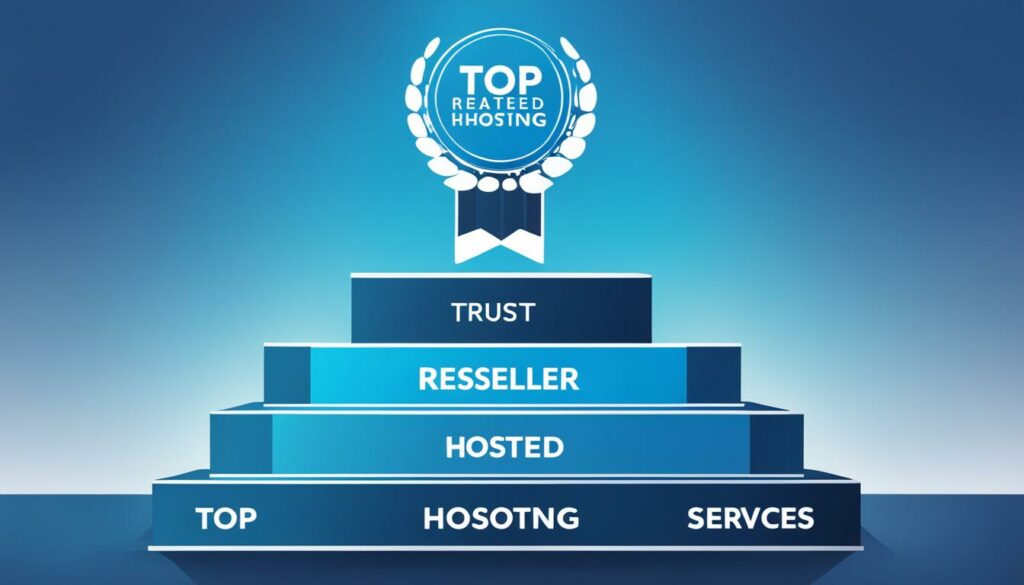Welcome to the world of advanced hosting solutions! In today’s digital landscape, businesses are increasingly relying on scalable hosting platforms to meet the demands of high-performance websites and applications. Multi-server hosting environments offer a robust solution that ensures your online presence remains accessible, reliable, and fast.
So, what exactly is a multi-server hosting environment? Simply put, it’s a setup where your website or application is distributed across multiple servers. This load-balanced and fault-tolerant hosting architecture allows for efficient resource allocation, improved scalability, and enhanced resilience.
Imagine having a cluster of servers working in harmony to handle your website traffic, ensuring smooth user experiences even during peak periods. With distributed server hosting, your online presence can handle any influx of visitors and ensure that your website remains up and running without a hitch.
Key Takeaways:
- Multi-server hosting environments offer advanced hosting solutions for high-performance websites and applications
- Benefits include scalability, reliability, load-balancing, and fault-tolerance
- Distributed server hosting ensures smooth experiences even during peak traffic periods
- Implementing a multi-server environment requires careful planning and configuration
- Monitoring and testing are crucial to ensuring optimal performance
What is a Multi-Server Web Environment?
A multi-server web environment involves using multiple servers to operate a web application, such as Magento 2. This configuration is ideal for businesses that experience heavy website traffic and require optimal performance. With a multi-server setup, resources can be efficiently allocated, and different server types can be utilized. Magento 2, being a resource-intensive software, benefits from a multi-server system to ensure uptime, security, and scalability. Amazon Web Services (AWS) offers a scalable and reliable infrastructure for hosting Magento 2 in a multi-server configuration.
The multi-server web environment leverages the power of multiple servers to provide a robust foundation for web applications like Magento 2. By distributing the workload and utilizing different server types, businesses can achieve high performance and meet the demands of heavy website traffic.
- Resource Allocation: In a multi-server setup, resources can be efficiently allocated based on the specific requirements of different components of the web application. For example, high-traffic areas can be assigned more resources for optimal performance.
- Server Types: Different server types can be utilized to handle specific tasks within the web environment. This includes web servers, database servers, caching servers, and more. Each server type is optimized for its designated role, improving overall efficiency.
- Scalability: The ability to scale resources horizontally is crucial for web applications experiencing growth or seasonal spikes in traffic. A multi-server web environment can easily accommodate increased demand by adding additional servers.
- Magento 2 Optimization: Magento 2 is known for its resource-intensive nature. By implementing a multi-server system, businesses can ensure that Magento 2 operates smoothly while maintaining high levels of uptime, security, and scalability.
- Amazon Web Services: AWS provides a scalable and reliable infrastructure for hosting Magento 2 in a multi-server configuration. With AWS, businesses can take advantage of advanced server management tools and services to optimize their web environment.
Benefits of a Multi-Server Web Environment for Magento 2:
- Improved performance and response times
- Enhanced scalability to handle increasing website traffic
- Better resource allocation and utilization
- Increased uptime and fault tolerance
- Higher security through distributed server architecture
| Server Type | Description |
|---|---|
| Web Servers | Handles incoming HTTP requests and hosts the web application |
| Database Servers | Stores and manages critical data for the web application |
| Caching Servers | Optimizes performance by caching frequently accessed data |
Leveraging AWS for Multi-Server Magento Performance
When implementing a multi-server configuration for Magento on AWS, several components play crucial roles. These components work together to optimize performance, enhance reliability, and ensure efficient resource allocation. Let’s take a closer look at each of these components:
Load Balancer
The load balancer is a vital component in a multi-server configuration. It evenly distributes network traffic across multiple servers, preventing any single server from being overwhelmed and improving overall performance and reliability.
Web Servers
Web servers play a central role in hosting web applications and handling incoming HTTP requests. By utilizing multiple web servers, the workload can be efficiently distributed, ensuring faster response times and higher availability.
NFS Server
An NFS (Network File System) server facilitates file sharing and resource access among servers in a multi-server configuration. It allows for seamless collaboration and data sharing, ensuring that critical resources are readily available to all servers.
Database Server
The database server stores and manages the data that is essential to the functioning of the web application. With multiple servers, the load can be distributed, ensuring efficient data access and minimizing the risk of data loss or downtime.
Caching Server
A caching server, such as Varnish Cache or AWS ElastiCache, plays a crucial role in optimizing performance. It caches frequently accessed data, reducing the load on the database server and significantly improving response times.

By leveraging the capabilities of Amazon Web Services (AWS), businesses can build a scalable and secure multi-server configuration for Magento. AWS provides the necessary infrastructure and tools to support the performance requirements of a multi-server setup.
With a robust multi-server configuration utilizing AWS, businesses can achieve high-performance hosting, scalable infrastructure, and enhanced reliability for their Magento web applications.
Best Practices for Maintaining a Multi-Server Setup
Implementing best practices for maintaining a multi-server setup is crucial for optimal performance and data access reliability. By following these practices, you can ensure the smooth operation of your server infrastructure and safeguard against potential vulnerabilities.
- Log-in Policy: Enforce a stringent log-in policy to limit unauthorized access to your servers. Implement strong password requirements and enable multi-factor authentication for added security.
- Centralized Event Logs: Centralize the collection of event logs from all servers in your environment to simplify the process of sorting, tracking, and categorizing events. This allows for efficient troubleshooting and forensic analysis in the event of an incident.
- Performance Benchmarks: Regularly conduct performance benchmarks to optimize software and hardware components within your multi-server setup. This helps identify bottlenecks, optimize resource allocation, and ensure optimal performance.
- Remote Access Restriction: Restrict remote access to your servers to minimize the risk of unauthorized access and potential security breaches. Utilize secure connection protocols, such as SSH, and employ IP whitelisting for remote access.
- Service Configuration: Streamline the configuration of services across your servers to eliminate unnecessary software dependencies and enhance overall system stability. Use standardized configurations and implement automated deployment tools where possible.
- Continuous Monitoring: Implement a robust monitoring system to proactively identify and address potential issues within your multi-server setup. Monitor resource utilization, network performance, and server health to ensure optimal operation.
- Patch Management: Regularly apply software updates and patches to your servers to address security vulnerabilities and ensure the latest bug fixes. Establish a patch management process that includes testing and implementation guidelines.
- Technical Controls: Implement robust technical controls, such as web application firewalls and intrusion detection systems, to fortify the security of your servers. Regularly audit and review these controls to ensure they remain effective against evolving threats.
- Physical Access Lockdown: Implement physical security measures to restrict access to your server infrastructure. Use secure data centers, implement access controls, and monitor physical server locations to minimize the risk of unauthorized access.
- Business Continuity Protection: Develop and regularly test a comprehensive business continuity plan to protect against data loss and system failure. Implement backups, disaster recovery processes, and redundant systems to ensure high availability and data integrity.
By following these best practices, you can ensure the reliability, security, and performance of your multi-server hosting environments, further enhancing the benefits they provide to your business.

Server Management Best Practices
| Best Practice | Description |
|---|---|
| Log-in Policy | Enforce strict log-in policies to limit unauthorized access to servers. |
| Centralized Event Logs | Collect and centralize event logs for efficient tracking and analysis. |
| Performance Benchmarks | Regularly conduct performance benchmarks to optimize server resources. |
| Remote Access Restriction | Restrict remote access to servers to minimize security risks. |
| Service Configuration | Streamline service configurations to eliminate unnecessary dependencies. |
| Continuous Monitoring | Implement a robust monitoring system to identify and address issues. |
| Patch Management | Regularly update servers with the latest software patches and fixes. |
| Technical Controls | Implement technical controls to fortify server security. |
| Physical Access Lockdown | Implement physical security measures to restrict access to servers. |
| Business Continuity Protection | Develop and test a comprehensive business continuity plan. |
Conclusion
Building and maintaining a multi-server environment requires careful planning, configuration, and monitoring. By implementing a multi-server setup, businesses can enjoy significant benefits, including improved performance, greater scalability, and increased redundancy. This makes it an attractive option for organizations looking to enhance their hosting capabilities.
Leveraging cloud infrastructure, such as Amazon Web Services (AWS), can further enhance the capabilities and flexibility of a multi-server configuration. AWS offers a scalable and reliable infrastructure that is well-suited for hosting multi-server environments, providing businesses with the resources they need to handle varying workloads.
To ensure the reliability, security, and performance of multi-server hosting environments, it is crucial to follow best practices for server management. This includes implementing controlled log-in policies, centralized event logs, and continuous performance monitoring. By taking proactive steps like patch management and technical controls, businesses can strengthen the security of their multi-server setup.
In conclusion, businesses can unlock the full potential of their hosting infrastructure by building and maintaining a well-planned, carefully configured, and meticulously monitored multi-server environment. By incorporating cloud infrastructure and adhering to best practices for server management, organizations can create a reliable, high-performing hosting environment that supports their evolving business needs.
FAQ
Q: What is a multi-server hosting environment?
A: A multi-server hosting environment is a configuration where multiple physical servers are used to distribute the load and provide redundancy. This setup improves reliability, scalability, and performance.
Q: Why should businesses consider a multi-server hosting environment?
A: Multi-server hosting environments offer reduced downtime, increased scalability and resilience, and cost-effectiveness. They are ideal for businesses that require high reliability, availability, and performance.
Q: What strategic considerations should be made when planning a multi-server environment?
A: Strategic considerations include forecasting growth, balancing budget constraints, and implementing access controls. Careful planning is crucial to ensure the success of a multi-server environment.
Q: What is a multi-server web environment?
A: A multi-server web environment involves using multiple servers to operate a web application, such as Magento 2. This configuration is beneficial for businesses that experience heavy website traffic and require optimal performance.
Q: How can Amazon Web Services (AWS) be leveraged for multi-server Magento performance?
A: AWS offers a scalable and reliable infrastructure for hosting Magento 2 in a multi-server configuration. Components such as load balancers, web servers, NFS servers, database servers, and caching servers contribute to optimizing performance and reliability.
Q: What are best practices for maintaining a multi-server setup?
A: Best practices include enforcing a controlled log-in policy, centralizing event logs, conducting performance benchmarks, restricting remote access, streamlining service configuration, implementing continuous monitoring, managing software updates, fortifying server security, and preparing for disaster recovery.












